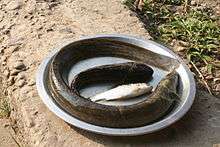Anguilla bengalensis
The mottled eel[3] (Anguilla bengalensis), also known as the African mottled eel, the Indian longfin eel, the Indian mottled eel, the long-finned eel or the river eel,[4] is a demersal, catadromous[5] eel in the family Anguillidae.[6] It was described by John McClelland in 1844.[7] It is a tropical, freshwater eel which is known from East Africa, Bangladesh, Andaman Islands, Mozambique, Malawi, Sri Lanka, Sumatra, and Indonesia and recently from Madagascar.[8] The eels spend most of their lives in freshwater at a depth range of 3–10 metres, but migrate to the Indian Ocean to breed. Males can reach a maximum total length of 121 centimetres and a maximum weight of 7,000 grams.[6] The eels feed primarily off of benthic crustaceans, mollusks, finfish and worms.[9]
| Anguilla bengalensis | |
|---|---|
 | |
 | |
| A. b. bengalensis | |
| Scientific classification | |
| Kingdom: | Animalia |
| Phylum: | Chordata |
| Class: | Actinopterygii |
| Order: | Anguilliformes |
| Family: | Anguillidae |
| Genus: | Anguilla |
| Species: | A. bengalensis |
| Binomial name | |
| Anguilla bengalensis (J. E. Gray, 1831) | |
| Subspecies | |
| Synonyms[2] | |
| |
The exact classification of the species was a debate in recent times, where some major fish websites (ex. Fish Base) classified the species under the name A. nebulosa. But according to the IUCN Red List 2015 version, the fish species should be classified as A. bengalensis with some subspecies.[10]
Subspecies
- Anguilla bengalensis bengalensis sometimes known as the Indian mottled eel.[11]
- Anguilla bengalensis labiata sometimes known as the African mottled eel.[12]
References
- Jacoby, D.; Harrison, I.J. & Gollock, M. (2014). "Anguilla bengalensis". IUCN Red List of Threatened Species. 2014. Retrieved 30 June 2014.CS1 maint: ref=harv (link)
- Synonyms of Anguilla nebulosa Archived 2016-03-08 at the Wayback Machine at www.fishbase.org.
- "Long-finned eel (Anguilla nebulosa) longevity, ageing, and life history".
- Common names for Anguilla nebulosa Archived 2016-03-10 at the Wayback Machine at www.fishbase.org.
- http://thewebsiteofeverything.com/animals/fish/Anguilliformes/Anguillidae/Anguilla-nebulosa
- Anguilla nebulosa Archived 2013-04-12 at Archive.today at www.fishbase.org.
- McClelland, J., 1844 (5 July) [ref. 2928] Apodal fishes of Bengal. Calcutta Journal of Natural History v. 5 (no. 18): 151-226, Pls. 5-14.
- Frost, Winifred E.; IMAMURA K (1957). "First Record of the Elver of the African Eel Anguilla nebulosa labiata Peters". Nature. 179 (4559): 594–5. Bibcode:1957Natur.179..594F. doi:10.1038/179594a0. PMID 13418745.
- Food items reported for Anguilla nebulosa at www.fishbase.org.
- Pike, C.; Crook, V.; Gollock, M.; Jacoby, D. (2019). "Anguilla bengalensis". IUCN Red List of Threatened Species. 2019: e.T61668607A96227813. doi:10.2305/IUCN.UK.2019-3.RLTS.T61668607A96227813.en. Retrieved 9 January 2020.
- Froese, Rainer, and Daniel Pauly, eds. (2006). Anguilla bengalensis bengalensis in FishBase. 05 2006 version.
- Froese, Rainer, and Daniel Pauly, eds. (2006). Anguilla bengalensis labiata in FishBase. 05 2006 version.
